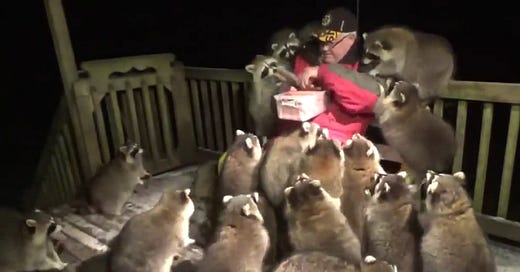People are funny about racoons. These flea-bitten, sometimes rabid, garbage-eating vermin with no visible means of support, elicit, in some people, feelings of love.
A woman in Canada was feeding dozens every day. When she died – of cancer, not rabies – her dying request to her husband was that he continue to feed the racoons. He has done so. And they’ve been fruitful, or at least they’ve multiplied.
A woman in Indiana feeds 25 or more a day. She buys 50-pound bags of dog food for them.
A woman in Colorado found what she called “a baby racoon.” She took it home and adopted it. She and about 20 of her friends adored it. When it grew bigger and problematic, she offered it to the local animal shelter. The shelter refused, and instead called the Health Department.
You can see where this is going. The Health Department showed up at the lady’s door, tested the racoon for rabies, the test was positive, and the lady and her 20 friends had to undergo rabies treatment.
Animals respond to incentives and disincentives. When you incentivize them to come around, they do. They’re soon at your doorstep, in your yard, in your trash, and, if you leave a door open, in your house.
National Geographic – not exactly a group of animal-haters – warns that wildlife experts say feeding the racoons ultimately endangers them by habituating them to busy streets, contributing to their overpopulation, and compromising their ability to fend for themselves.
So it is with vagrants. These flea-bitten, sometimes rabid, garbage-eating vermin with no visible means of support, elicit, in some people, feelings of love.
Those people feed the vagrants. Sometimes food but mainly money. The results are predictable. They’re not fruitful but they do multiply.
Word gets out, and they come from miles around for the freebies. Soon they’re camped under the viaducts, then in the parks, and finally on the sidewalks in their own poop. If you leave a door open, or even closed, they may wind up in your house.
Squatters.
Vagrants rarely have rabies, but they usually have other diseases such as alcoholism, drug abuse, insanity and lice. Their panhandling – presented as a pathetic attempt to get food – is typically a fraudulent means to get money to buy alcohol or drugs.
People who give vagrants money at the stoplights are contributing to their substance diseases. For a moment of selfish feelgoodery, those people are accomplices in the vagrants’ self-destruction.
Giving them food is not as bad as giving them money, since liquor stores and drug dealers don’t take food in payment for liquor and drugs. But it still enables and encourages their lives on the street.
The vagrant-enablers who’ve read this far now think I’m an evil and sadistic person who wants to see vagrants freeze and starve.
That’s not so. I’d like to see them get help. But giving them food or money does not help them; it enables them to keep their lives miserable and to spread some of their misery to the rest of us.
Real help is available at the homeless shelters. There, they can get food and shelter, and can get pointed in the right direction for treatment of their substance addictions and other diseases. The shelters are not likely to call the Health Department, though in appropriate cases they might test them for rabies and they’ll certainly call an ambulance for anyone with a serious, imminent medical condition.
I was interested in the phenomenon of “homeless” people when they first became fashionable some years ago. I spent some time on the streets, did a little panhandling (I scored a Benjamin on the streetcorner in Aspen!) and spoke with many people at the shelters.
Somewhat to my surprise, the staff of the shelters invariably begged me to tell people not to feed the vagrants, for the reasons I’ve stated. Money given to them goes to buy drugs and alcohol, and food given to them enables their vagrancy.
The way to help the vagrants, I was told repeatedly by the shelter staff, is to give them directions to the shelter where they can get food and shelter along with real help and real treatment.
These people don’t need sympathy and freebies. They need treatment and consequences. They need tough love.
For some, their treatment should include involuntary hospitalization in specialized facilities – mental hospitals. Before we became so “compassionate,” we used to give such treatment to people who needed it.
The movie called “One Flew Over the Cuckoo’s Nest” was instrumental in discrediting such treatment. It was a brilliant movie, but a destructive message that mental institutions are cruel.
It’s a fact that some people need treatment, are not willing to undergo it voluntarily, but are immensely grateful afterward if they get it. It’s a Catch 22 situation, to borrow from another great movie. The people are so insane that they need treatment but are so insane that they won’t voluntarily undergo it.
Should freedom extend so far that we permit insane people to insanely refuse treatment – to the detriment of them and us? Should we allow insane people in need of treatment to insanely reduce themselves to something worse than a racoon?




Same is unfortunately true of immigrants and sanctuary cities. But no matter what our collective attitude towards immigrants or our policies for dealing with them, people in the grip of destitution will always see the United States as an open 50 lb. bag of dog food.
Nice analogy. No doubt you were inspired by those little black Frito Bandito masks that raccoons have.